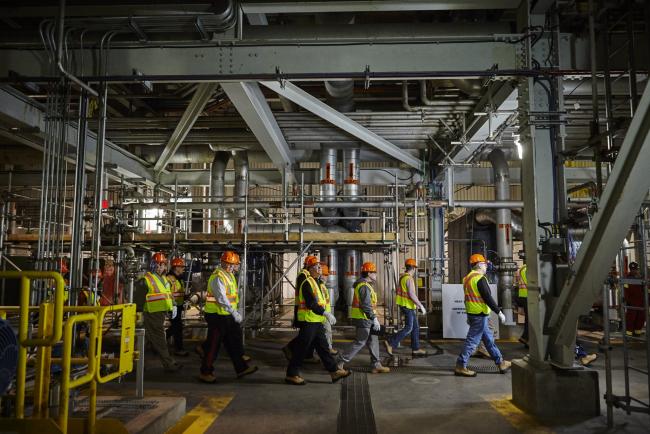Leading climate scientists and academics are calling on the federal government to abandon a proposed tax credit that gives big polluters a break for investing in carbon capture technology.
The experts say the planned carbon capture utilization and storage (CCUS) tax credit will lock in fossil fuel use and risk ruining Canada’s chances of meeting emission reduction goals.
In a letter signed by more than 400 experts and sent to the federal government’s finance, natural resources and environment departments Wednesday, the group warned a tax credit that incentivizes carbon capture technologies amounts to a major new fossil fuel subsidy — something the federal government has repeatedly promised to phase out.
“When we're focusing our resources and attention on technologies that are prolonging fossil fuel use, it means we have less resources and less attention to focus on technologies and innovations that will allow us to move away from fossil fuel use,” said Christina Hoicka, an associate professor at the University of Victoria who drafted the letter with a handful of others.
She described the letter as “a really big cross-section of scholars of energy and climate change in Canada,” including “many Canada research chairs, as well as authors of the reports for the Intergovernmental Panel on Climate Change.”
Carbon capture technology refers to the methods used by companies to trap carbon dioxide released during industrial processes. This prevents it from reaching the atmosphere and contributing to global warming. Some varieties of the technology can capture carbon released when fuel is burned and even suck carbon directly out of the air. Once the carbon dioxide is captured, it can be stored indefinitely underground or transported through pipes for different industrial uses.
In Canada, SaskPower’s coal-fired power plant Boundary Dam installed a generator equipped with carbon capture technology in 2014, initially promising to trap 90 per cent of emissions. Boundary Dam is one of the country’s top emitters, pumping out about five million tonnes of greenhouse gas emissions in 2019. According to the Institute for Energy Economics and Financial Analysis, the plant has consistently failed to meet its promised carbon capture goals. Its plan to capture 90 per cent of emissions was dropped in favour of an easier 65 per cent target, but the facility still fails to regularly meet that, too.
Even though carbon capture technologies remain largely ineffective, they are being touted by fossil fuel producers as a viable way to lower their emissions during the production process. In Alberta, proposals for a “carbon grid” have been swirling that would see a network of pipelines connect the province’s oilsands operations in the hope of creating a massive market for the greenhouse gas.
While some environmentalists applaud any emission reductions, others are concerned about technologies that allow for sustained fossil fuel use. That’s because even if emissions from the production and refining of oil could be brought to zero, 80 per cent of the oil and gas sector’s pollution comes when its product is ultimately burned, and there is still no way to trap the carbon that comes out of a tailpipe.
The primary market for captured carbon is also among oil and gas companies, which use it for enhanced oil recovery. This involves injecting CO2 into an oil reservoir, making it easier to produce more oil. At SaskPower’s Boundary Dam, for example, most of the carbon captured is used for enhanced oil recovery. The letter notes that globally, 80 per cent of captured carbon is used for this purpose.
With a rapidly shrinking timeline to slash emissions, carbon capture won't be an effective way to deal with climate change before catastrophe hits, warn hundreds of experts in a letter to the federal government. #cdnpoli - Twitter
But there are some more benign uses for the captured carbon as well. Some refineries, like the Irving Oil refinery in Saint John, N.B., captures carbon dioxide from its industrial process for use in carbonated drinks. In Irving Oil’s case, it pipes CO2 to a facility owned by Linde Canada. It’s a relatively small amount of the refinery’s total emissions, however: in 2019, Irving Oil spewed 2.9 million tonnes of CO2 equivalent greenhouse gas emissions into the atmosphere and reported capturing only about 53,000 tonnes.
Consultations on the CCUS tax credit kicked off in June, with the federal government eager to develop technology that can trap carbon emissions from heavy-emitting sectors. The tax credit is expected to be available to companies later this year.
Ottawa has said the credit will be available for “a broad range” of applications, including direct air capture (sucking carbon dioxide right out of the atmosphere), blue hydrogen projects or to industrial sectors like concrete production and fuel refining, but it’s not intended for enhanced oil recovery projects. Blue hydrogen refers to hydrogen produced using natural gas with carbon capture technology applied. As previously reported by Canada’s National Observer, the federal government is on the hunt to include the oil and gas industry in the country’s hydrogen plans.
In a recent interview with Bloomberg, Natural Resources Minister Jonathan Wilkinson reportedly said the credit would look similar to an incentive in the U.S. and confirmed carbon capture used to boost oil production would not be included.
The letter warns against enhanced oil recovery but more broadly takes issue with the tax credit serving as a fossil fuel subsidy. It also points to the U.S. carbon capture credit, called Section 45Q, and says if Canada is going to adopt something similar, it should learn from America’s mistakes. The top finding is that 45Q has been a major boon to American oil companies that could result in an extra 400,000 barrels of oil per day by 2035. That translates into roughly 50 million tonnes of added carbon emissions annually.
In essence, “deploying CCUS at any climate-relevant scale, carried out within the short timeframe we have to avert climate catastrophe without posing substantial risks to communities on the front lines of the buildout, is a pipe dream,” the letter reads.
The letter does offer a few recommendations if Ottawa chooses to push forward. They are to ensure enhanced oil recovery projects aren’t eligible, that the credit only be available to sectors where there are no decarbonizing options available, carbon capture efforts are independently monitored and verified, that long-term environmental and fiscal risks around CO2 storage sites are met before credits are issued, and that Indigenous and front-line communities are included in the design of the tax credit to help hold companies accountable.

